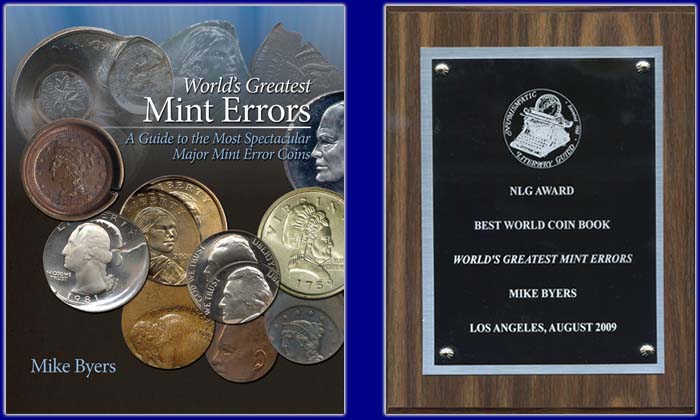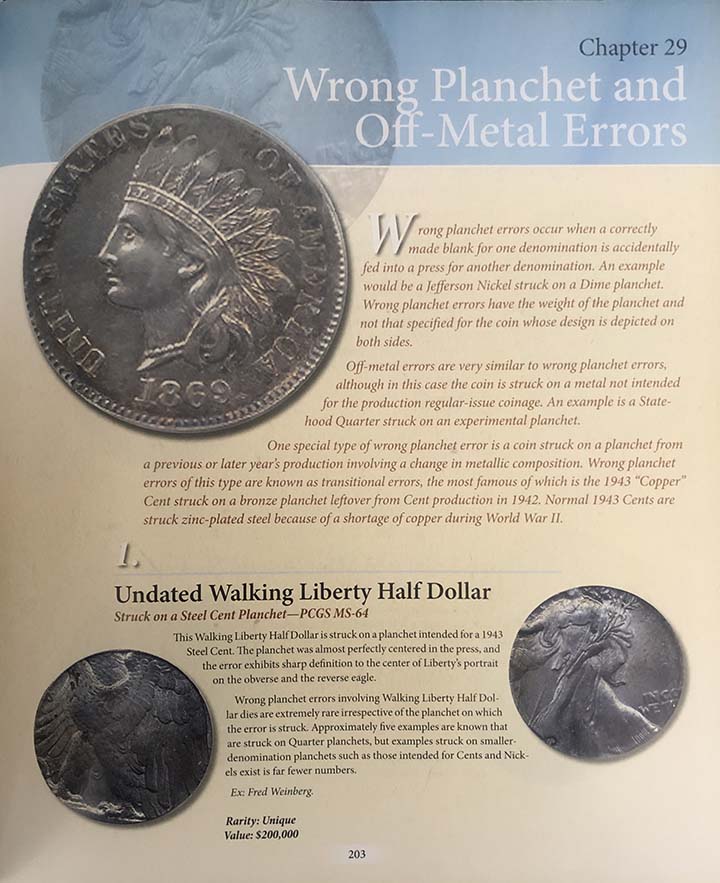1974-S Aluminum Lincoln Cent
Struck by the Obverse Die Only
On Philippine 1 Sentimo Planchet
PCGS MS 61
UNIQUE
SOLD
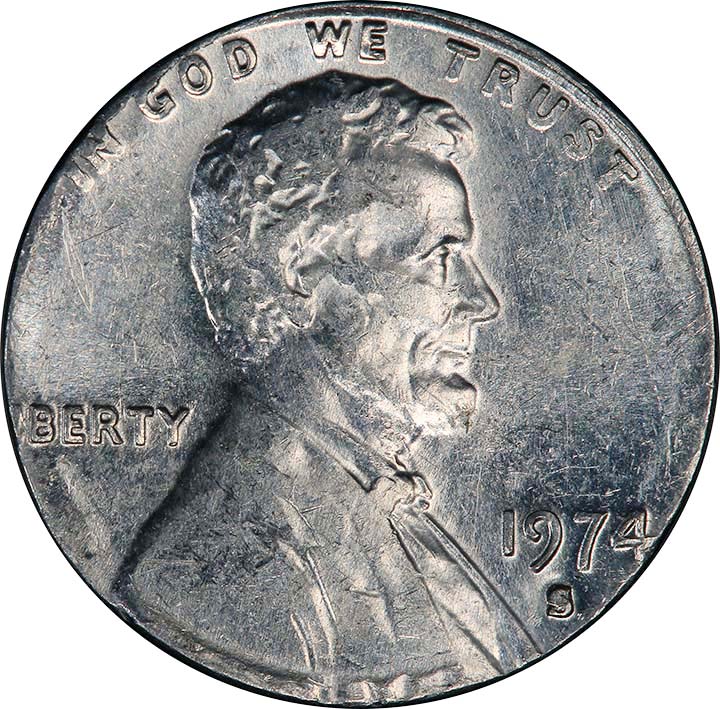
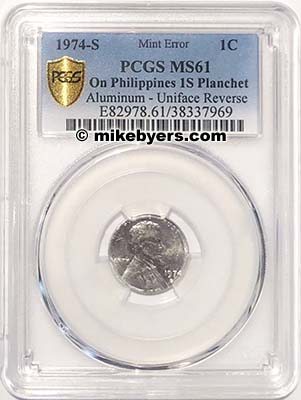
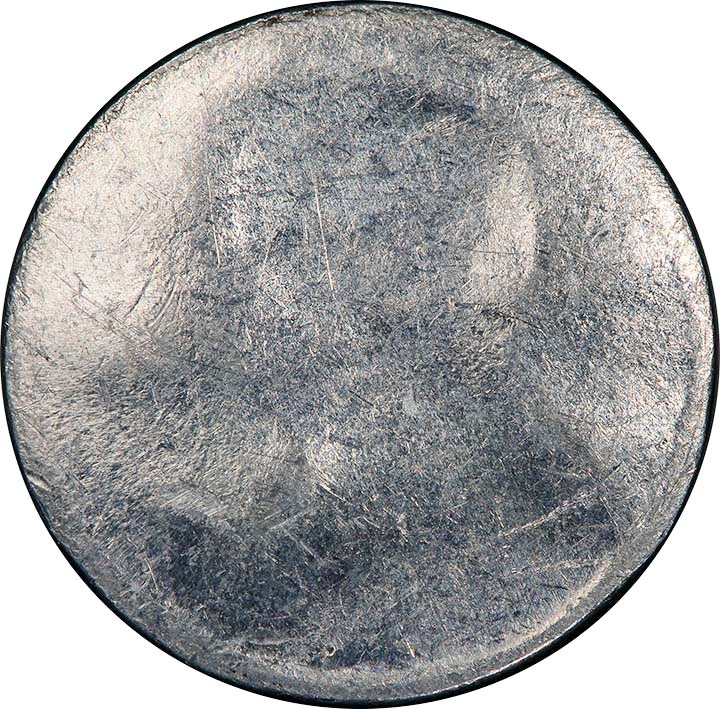
According to the Chief of the Mint's internal audit staff, Willian Humbert, between October 17, 1973 and March 29, 1974 there were 1,441,039 aluminum cents dated 1974 struck at the Philadelphia Mint. Another 130,128 were struck between April 12, 1974 and May 30, 1974. Fred Weinberg, PCGS authenticator for Mint Errors, estimates that the number ranges from (5) to as many as (14) 1974-P aluminum cents that are not accounted for. The U.S. Government closed it's investigation of any missing 1974 aluminum cents in February 1976.
In 2014, a 1974 Denver Mint aluminum cent surfaced from Randall Lawrence, who stated that his father had worked at the U.S. Mint in Denver and had received it as a retirement gift. It was certified MS 63 by PCGS and was subsequently surrendered to the U.S. Government since it was not authorized for release.
This spectacular and unique 1974 San Francisco Mint aluminum cent was only struck by the obverse die (uniface). The planchet was intended for a Philippine 1 Sentimo, which were struck by the San Francisco Mint in 1974. There are no authorized U.S. coins that were struck in aluminum for circulation. In 1974, Lincoln Cents were composed of 95% copper and 5% zinc. Since 1982, they are composed of 97.5% zinc and 2.5% copper.
For comparison purposes, a 1971 San Francisco Mint aluminum cent was struck on a planchet intended for Nepal or the Philippines and was certified by NGC as AU 58. It sold in the March 2005 Heritage Signature Sale #368 for $8,050 (lot #7604). On February 27, 2021 the new owner rejected an offer of $12,075 on the Heritage auction website. As spectacular as the 1971 San Francisco aluminum cent is, it does not begin to compare to this 1974 San Francisco aluminum cent which was struck during the same year that the Philadelphia and Denver Mints struck experimental aluminum cents that were not released. There is also a proof 1974-S Lincoln Cent struck on an Nepal 2 Paisa aluminum planchet certified by PCGS PR 68.
As incredible as it seems, there is a unique 1977 Aluminum Cent that was discovered and certified by NGC. It was struck on an aluminum planchet with a weight of 1.04 grams. There are several possibilities as to how this unique Lincoln Cent was produced. It could have been an intentionally made mint error. It could have been struck on a leftover aluminum blank from 1974-75 when the U.S. Mint in Philadelphia struck Aluminum Cents. Or it could be a unique and unrecorded pattern struck in aluminum. Regardless of the circumstances, it is a unique and enigmatic Lincoln Cent.
Although this 1974-S Aluminum Cent is designated as a mint error by PCGS, there is no way to determine if this was intentionally created or is a mint error due to malfunctions that occurred during the minting process in San Francisco. There are two possibilities. Either scenario starts with a planchet intended for a Philippine 1 Sentimo struck from 1967 through 1974. The composition is 95% aluminum and 5% magnesium. It weighs .5 grams, has a diameter of 15.25 mm and a thickness of 1.37 mm.
If this mint error was intentionally struck at the San Francisco Mint to create a 1974 aluminum Lincoln cent during the same time period that the Philadelphia and Denver Mints were striking experimental 1974 aluminum cents, several steps would have been necessary. Since there weren't any aluminum planchets produced in San Francisco to test strike the 1974 cents, a Mint employee took an aluminum planchet intended for the Philippine 1 Sentimo, placed it on top of a U.S. copper-zinc cent planchet in the collar so that only the obverse die struck the aluminum planchet. Finally this unique mint error had assistance leaving the San Francisco Mint.
This scenario is entirely plausible since in the 1970's, the San Francisco Mint was well known to have intentionally created spectacular proof errors and a few mint state errors as well. These errors were auctioned off by the State of California after they were discovered in a bank safe deposit box. The U.S. Secret Service inspected and released the collection, determining that it was legal to own. The State of California then auctioned off the collection and it has been dispersed since the sale.
In the collection were incredible proof errors that were double denominations, mated pairs, dramatic and spectacular unique mint errors including the famous 1970-S Quarter struck on a Barber Quarter certified by NGC as PR 65. Also in this collection was the now world famous 1970-S Quarter struck on a 1941 Canadian Quarter which went viral worldwide on the internet, TV, print and in magazines. In addition, there were several unique and exotic mint state errors in the collection that were unknown types of errors including a unique mint state Roosevelt Dime struck with two reverse dies, which was subsequently certified by PCGS. Creating a 1974 San Francisco aluminum cent was not out of the realm of possibilities given the fact that unique mint errors were being intentionally struck in the San Francisco Mint and had assistance leaving the Mint as well.
The other possibility is that this aluminum cent was a mint error caused by malfunctions that occurred during the minting process striking 1974 copper Lincoln Cents at the San Francisco Mint. A leftover aluminum planchet intended to produce the 1974 Philippine 1 Sentimo was somehow mixed in the bin of blanks or somewhere else along the path from producing blanks to striking Lincoln Cents. So far, this scenario is possible since many off-metal errors are known. But very few U.S. coins are known struck on aluminum planchets from foreign countries. In addition, the aluminum planchet had to be in the collar at the exact time that a cent planchet was also in the collar, which is a rare occurrence. This would have created this unique mint error struck only by the obverse die and the reverse would be uniface since it was on top of a cent planchet. Additionally it would have to escape the quality control procedures implemented by the San Francisco Mint.
Furthermore, an interesting event transpired with the mint state 1974-S cents. They were being hoarded and speculated on, with $50 bags selling for $475. To prevent the hoarding, the U.S. Mint Director Mary Brooks ordered that the cents from the San Francisco Assay Office be mixed with those of the other Mints in unlabeled bags before being shipped to the Federal Reserve Banks. It is common to find 1974-S rolls of cents that are mixed with other mint marks. This was yet another process that this mint error had to survive. And last but not least, it is coincidentally and magically also dated 1974, the same date as the 1974 aluminum cents struck in Philadelphia and Denver.
Regardless of the circumstances surrounding the intentional or non-intentional striking of this unique aluminum cent, it carries the mystique and excitement that surrounds the world famous 1974 aluminum cents. Certified by PCGS as MS 61, this 1974-S aluminum Lincoln Cent belongs in a world class collection of Lincoln Cents or in a collection of unique rarities, discovery coins, patterns and mint errors.


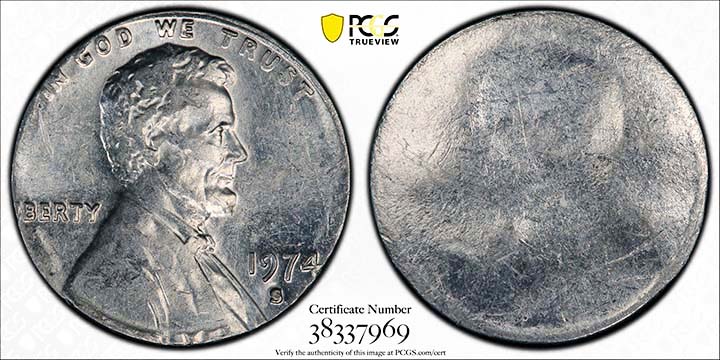
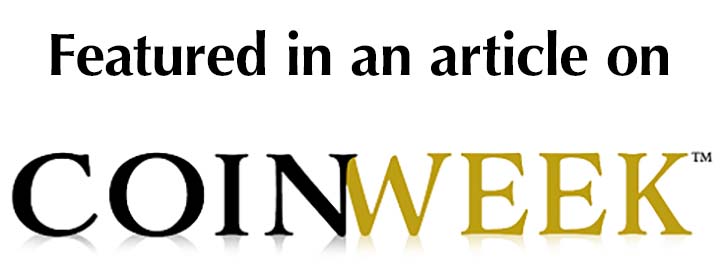
Featured on the cover of Mint Error News Magazine Issue 55:
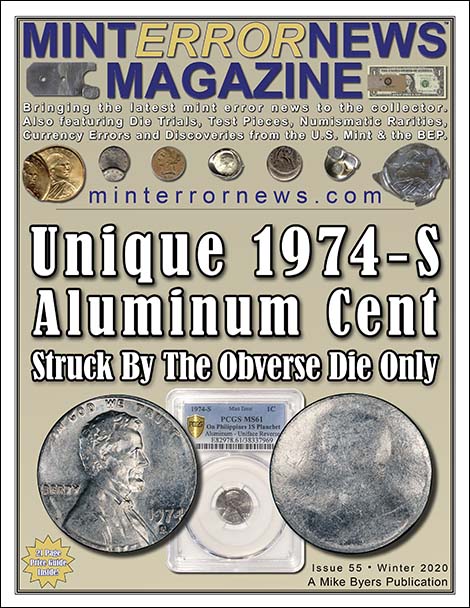
The Mint Error News website has a 69 page report of coins struck by the U.S. Mint for foreign countries. It is the most comprehensive report available anywhere.

Wrong Planchet and Off-Metal Errors are featured in Chapter 29
of my NLG award winning book, World's Greatest Mint Errors:
